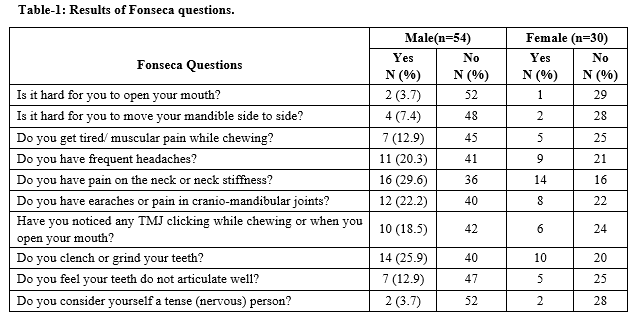Prevalence of temporomandibular disorders in MBBS students – A study from north India
Abstract
Introduction: The Fonseca questionnaire is a self-administered questionnaire that has been proposed as a low-cost, easily applied alternative TMD assessment tool for the non-patient population. It serves as a preliminary screening tool for TMD.
Material and methods: It was a cross-sectional descriptive study conducted by the general surgery department ofHind Institute of Medical Science, Safedabad, Barabanki, Uttar Pradesh from March 2018 to May 2018. The minimum sample size required for the study was found to be 360 to obtain CI level of 0.95, at least 80% power for analysis and minimal error. The sample size was kept to be 450 as the students volunteered for the research.
Results: The most common symptom was pain on neck or neck stiffness seen in 30% of the males and 47 % females, second most common symptom found was the habit of clenching or grinding the teeth seen in 26% of the males and 33% of the females. Regarding the presence of TMDs, 60% of the participants were scored to have mild TMD, 4.7% were scored to have moderate TMD sand only 1.5 % were scored to have severe temporomandibular disorders.
Conclusion: A simple Anamnestic index is of use in identifying and classifying TMJ and TMD symptoms in patients according to the severity of the disorder. Identification and follow-up of the prevalence and health-care needs of patients with TMDs are recommended with longitudinal studies.
Downloads
References
De Oliveira AS, Dias EM, Contato RG, Berzin F. Prevalence study of signs and symptoms of temporomandibular disorder in Brazilian college students. Braz Oral Res. 2006;20(1):3-7. doi: https://doi.org/10.1590/S1806-83242006000100002.
Graber R, Rakosi T. Petrovic. Dentofacial Orthopedics with Functional Appliances. 2nd ed. St. Louis: Mosby. 2009:135-140.
Schiffman E, Fricton JR. Epidemiology of TMJ and craniofacial pain: Diagnosis and management. In: Kraus SL, editor. The TMJ Disorders Management of the Craniomandibular Complex. New York: Churchill Livingstone; 1998. pp. 23-38.
Olivares HA, Saucedo FL, Nova AP. Temporomandibular joint disorder prevalence in resident physicians at the specialties hospital La Raza national medical center. Rev Odontol Mex. 2016;20(1):8-12. doi: 10.1016/j.rodmex.2016.02.009.
Habib SR, Al Rifaiy MQ, Awan KH, Alsaif A, Alshalan A, Altokais Y. Prevalence and severity of temporomandibular disorders among university students in Riyadh. Saudi Dent J. 2015;27(3):125-130. doi: https://doi.org/10.1016/j.sdentj.2014.11.009.
Dworkin SF, LeResche L. Research diagnostic criteria for temporomandibular disorders: Review, criteria, examinations and specifications, critique. J Craniomandib Disord. 1992;6(4):301-355.
Helkimo M. Studies on function and dysfunction of the masticatory system. II. Index for anamnestic and clinical dysfunction and occlusal state. Sven Tandlak Tidskr. 1974;67(2):101-121.
Fonseca DM. Craniomandibular Dysfunction (DCM): Diagnosis by the Anamnesis [Master's Dissertation] Bauru: Faculty of Dentistry of Bauru of USP; 1992.
Nomura K, Vitti M, Oliveira AS, Chaves TC, Semprini M, Siéssere S, et al. Use of the Fonseca's questionnaire to assess the prevalence and severity of temporomandibular disorders in Brazilian dental undergraduates. Braz Dent J. 2007;18(2):163-167. doi: https://doi.org/10.1590/s0103-64402007000200015.
Da Fonseca DM, Bonfante G, Valle AL, de Freitas SFT. Diagnósticopelaanamnese da disfunçãocraniomandibular. Rev Gauch de Odontol. 1994;4(1):23-32.
Solberg WK, Woo MW, Houston JB. Prevalence of mandibular dysfunction in young adults. J Am Dent Assoc. 1979;98(1):25-34. doi: https://doi.org/10.14219/jada.archive.1979.0008.
Klineberg I, McGregor N, Butt H, Dunstan H, Roberts T, Zerbes M. Chronic orofacial muscle pain: A new approach to diagnosis and management. Alpha Omegan. 1998;91(2):25-28.
Shiau YY, Chang C. An epidemiological study of temporomandibular disorders in university students of Taiwan. Community Dent Oral Epidemiol. 1992;20(1):43-47. doi: https://doi.org/10.1111/j.1600-0528.1992.tb00672.x.
Karthik R, Hafila MIF, Saravanan C, Vivek N, Priyadarsini P, Ashwathi B. Assessing Prevalence of Temporomandibular Disorders among University Students: A Questionnaire Study. J Int Soc Prev Community Dent. 2017;7(1):S24-S29. doi: https://doi.org/10.4103/jispcd.jispcd_146_17.
Rokaya D, Suttagul K, Joshi S, Bhattarai BP, Shah PK, Dixit S. An epidemiological study on the prevalence of temporomandibular disorder and associated history and problems in Nepalese subjects. J Dent Anesth Pain Med. 2018; 18(1):27-33. doi: https://doi.org/10.17245/jdapm.2018.18.1.27.

Copyright (c) 2020 Author (s). Published by Siddharth Health Research and Social Welfare Society

This work is licensed under a Creative Commons Attribution 4.0 International License.


 OAI - Open Archives Initiative
OAI - Open Archives Initiative


















 Therapoid
Therapoid

